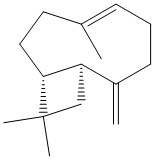Home
Products
trans-Caryophyllene



| Product Name | trans-Caryophyllene |
| Price: | $46 / 100mg |
| Catalog No.: | CN09326 |
| CAS No.: | 87-44-5 |
| Molecular Formula: | C15H24 |
| Molecular Weight: | 204.36 g/mol |
| Purity: | >=98% |
| Type of Compound: | Sesquiterpenoids |
| Physical Desc.: | Oil |
| Source: | The seeds of Alpinia katsumadai Hayata. |
| Solvent: | Chloroform, Dichloromethane, Ethyl Acetate, DMSO, Acetone, etc. |
| SMILES: | CC1=CCCC(=C)C2C(CC1)C(C2)(C)C |
| Contact us | |
|---|---|
| First Name: | |
| Last Name: | |
| E-mail: | |
| Question: | |
| Description | β-Caryophyllene is a CB2 receptor agonist. |
| Target | CB2 receptor[1] |
| In Vitro | Among the tested cancer cells, β-Caryophyllene demonstrates selective anti-proliferative effect against three cancer cell lines, namely HCT 116 (colon cancer, IC50=19 μM), PANC-1 (pancreatic cancer, IC50=27 μM), and HT29 (colon cancer, IC50=63 μM) cells, whereas β-Caryophyllene exhibits either moderate or poor cytotoxic effects against ME-180, PC3, K562 and MCF-7. Results show that β-Caryophyllene possesses higher selectivity towards the colorectal cancer cells (HCT 116), with selectivity index (SI)=27.9, followed by PANC-1 and HT 29 cells with SI=19.6 and 8, respectively. The apoptotic index estimated for β-Caryophyllene treatment on HCT 116 cells after 24 h treatment is 64±0.04. β-Caryophyllene at 10 μM concentration, causes significant nuclei condensation after 6 h of treatment. β-caryophyllene exhibits a dose and time-dependent inhibitory effect on the motility of HCT 116 cells[2]. |
| In Vivo | Treatment with β-Caryophyllene at different doses does not show any effects on swimming speed during the test. Oral treatment with β-Caryophyllene ameliorates the rise in β-amyloid deposition in the transgenic mice in a roughly dose-dependent manner, and the two higher doses exhibit almost equal effects in modifying the β-amyloid burden. The number of activated astroglial cells is higher in vehicle-treated mouse brains than in β-Caryophyllene-treated mouse brains with different doses. β-Caryophyllene is effective at reducing the enhancement of the COX-2 protein level found in vehicle-treated APP/PS1 mice[1]. Animals treated with β-Caryophyllene display higher values of object recognition index than their vehicle-treated counterparts [t(14)=4.204, P<0.05]. The total time spent in object exploration during the test trial is not significantly different between β-Caryophyllene-treated and vehicle-treated animals (t(14)=0.5874, P>0.05). Treatment with β-Caryophyllene does not significantly alter these seizure-induced neurochemical changes[3]. |
| Cell Assay | Panel of human cancer cells such as, pancreatic (PANC-1), colorectal (HCT-116 and HT-29), invasive squamous cell carcinoma (ME-180), leukemia (K562), hormone sensitive and invasive breast cancer cell line (MCF-7), and prostatic (PC3) adenocarcinoma cell lines are used. Cells are incubated in a humidified CO2 incubator at 37°C supplied with 5% CO2. Inhibitory effect of β-Caryophyllene on proliferation of the cell lines is tested using the MTT assay. The selectivity index (SI) for the cytotoxicity of β-Caryophyllene is calculated using the ratio of IC50 of β-Caryophyllene on a normal cell line (NIH-3T3) to the IC50 of β-Caryophyllene on cancer cell lines[2]. |
| Animal Admin | Male double transgenic APP/PS1 mice and wild-type littermates are used. The mice are group housed (3 to 5 animals/cage) with a 12:12-hour light/dark cycle and ad libitum access to food and water. In this experiment, animals are orally treated by gavage with 16, 48, or 144 mg/kg of β-Caryophyllene every morning for 10 weeks starting at the age of 7 months. All vehicle solutions are used for the respective control animal treatments and the Morris water maze test is performed[1]. |
| Density | 0.9±0.1 g/cm3 |
| Boiling Point | 268.4±10.0 °C at 760 mmHg |
| Flash Point | 104.9±13.8 °C |
| Exact Mass | 204.187805 |
| LogP | 6.78 |
| Vapour Pressure | 0.0±0.3 mmHg at 25°C |